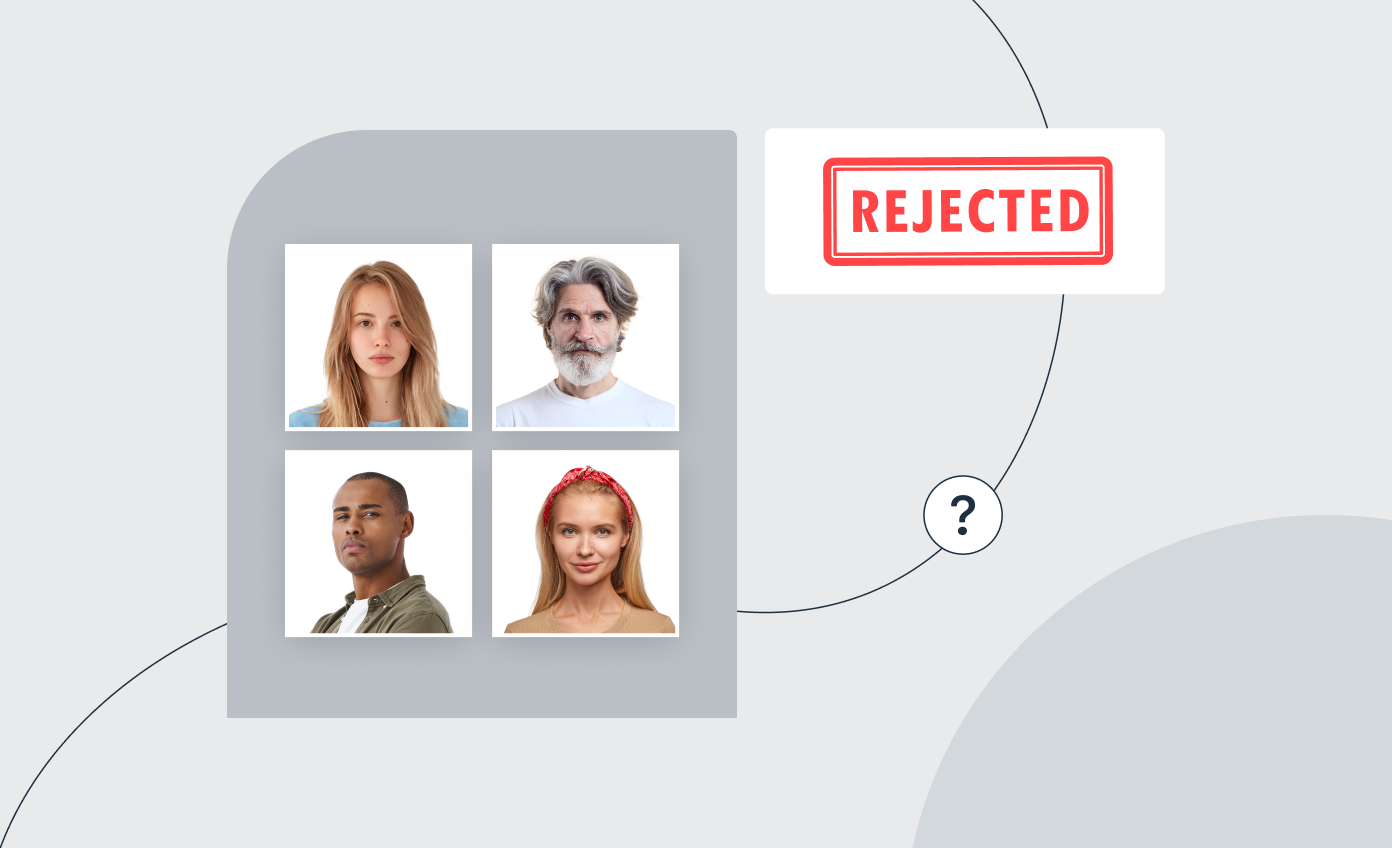As the leading passport photo service, we process around 11M passport and visa photos every year.
With our AI algorithms followed by a human verification step, we ensure every photo meets regulatory standards.
But—
Sometimes, people opt to take their own ID photographs, which can lead to an application delay if they’re deemed non-compliant.
To help mitigate these setbacks, we’ve analyzed 10,083 faulty ID photos from our users in the United States, Great Britain, Australia, New Zealand, Canada, and Ireland and uncovered the most common errors.
Read on for our findings.
The Six Culprits Behind ID Photo Rejections
Our customer support agents categorize the mistakes made in photos into six main buckets. We then identify the specific reasons for rejections within each group.
Let’s look at the key areas where the analyzed ID photos didn’t make the cut*:
- Subject’s position: 55.7%
- Lighting: 45.8%
- Facial expression: 33.7%
- Image quality: 29.8%
- Appearance: 14%
- Children’s photos: 6.3%
*The images studied often had multiple issues, fitting into several categories at once.
As you can see, the primary causes of ID photo rejections are the subject’s position (56%), lighting (46%), and facial expression (34%).
Now—
In the next segment, we’ll dive into the most common reasons for non-acceptance within the above categories.
Subject’s Position
The first bucket is the subject’s position.
Below are the specific postural issues leading to ID photo refusals:
- Poor torso visibility (33.5%*): The photo doesn’t include the head and torso below the chest, failing to capture both arms within a reasonable distance.
- Semi-profile orientation (9.4%): The image is captured in semi-profile instead of directly facing the camera.
- Lowered camera angle (3.3%): The lens is positioned lower than the face and eyes, leading to an unfavorable perspective.
- Too far from the camera (3.0%): The photo’s frame is too wide, not capturing the head and torso from an adequate distance.
- Raised camera angle (2.7%): The photo is taken from above, where the lens is higher than the face and eyes.
- Incorrect arm positioning (1.8%): The subject’s arms aren’t directed towards the camera, indicating a side or angled posture.
- Elevated chin position (1.0%): The person’s chin is too high.
- Head tilt (1.0%): A head tilt, side-to-side or up-and-down, is present.
*The percentages refer to the share of photos rejected for this specific reason. This also applies to all subsequent sections.
The data shows most rejections stem from incorrect body orientation relative to the camera.
How to fix: Ensure your ID photo includes your head and full torso with both arms visible. Face the camera directly without tilting your head, and maintain the camera at eye level.
Lighting
As far as lighting is concerned, there are fewer causes for refusal.
Below are the most common ones:
- Uneven lighting (14.7%): The face isn’t evenly lit, often due to standing too far from or at an angle to the primary light source, resulting in one side being brighter.
- Face shadows (10.6%): Shadows appear on the face, usually from incorrect positioning relative to the light source, obscuring facial features.
- Insufficient lighting (9.4%): The lighting makes the face underlit and details hard to discern.
- Side lighting imbalance (7.4%): One side of the face is significantly more lit than the other, often due to improper alignment with the window or primary light source.
- Backlighting issue (3.7%): Light from behind the subject, such as from a window or lamp, causes the face to be in shadow or too dark to see clearly.
How to fix: Get even lighting across the face, avoid shadows or backlighting, and manage the lighting source to prevent one side of the face from being brighter.
Facial Expression
Moving on to the “facial expression” category, here’s a breakdown of the common mistakes identified:
- Mouth open (21.3%): The mouth isn’t fully closed.
- Unnatural facial expression (4.3%): There’s a broad smile that alters the facial features.
- Indirect gaze toward the camera (4.2%): The subject’s eyes aren’t aligned with the camera lens.
- Eyes not fully open (3.5%): The eyes aren’t sufficiently open, compromising the visibility of the irises and pupils.
- Obstructed eyebrows (0.4%): Eyebrows are partially or fully covered by hair or other obstructions.
How to fix: Maintain a neutral facial expression with your mouth closed. Additionally, gaze directly into the camera with your eyes open and brows visible.
Image Quality
So far, so good.
Let’s now look at the image quality category.
This section highlights technical flaws that often lead to ID photo rejections. Based on the analysis, here are the common mistakes:
- Low resolution (13.2%): The photo suffers from low resolution, often due to using a secondary (front-facing) camera instead of the primary (rear-facing) one.
- Blur (8.3%): The image is blurry, indicating movement or lack of focus during capture.
- Photo of a photo (5.4%): The submission is a reproduced photo.
- Applied filters (1.7%): The original appearance of the photo has been altered via filters or editing techniques.
- Screenshot of a photo (1.0%): The image is a screenshot.
- Black and white photo (0.2%): The photograph is black-and-white.
How to fix: Ensure your ID photo is high-resolution, taken with a primary camera, free of blur, directly captured without reproducing or screenshotting, in natural color without filters, and not black and white.
Appearance
Diving into our penultimate category, here’s an overview of the common issues that lead to rejections:
- Glasses causing reflections or obscured eyebrows (3.5%): The subject is wearing glasses, which cast reflections or hide eyebrows.
- Hair covering the face (3.2%): The person’s hair falls over the face, obscuring key features such as the eyes.
- Glasses in US photos (3.1%): There are glasses present, which isn’t permissible in US ID photos except under specific medical exemptions.
- Headwear (2.3%): The photo includes clips, scarves, or hats, which aren’t generally allowed unless worn for religious reasons.
- Improper clothing (0.9%): The subject isn’t dressed in suitable clothing, such as a simple shirt.
- Visible hoodie (0.5%): A hoodie is visible in the shot, which is considered inappropriate clothing for an ID photo since it can obscure the neck.
- Covered ears (0.2%): The subject’s ears are covered.
- Camouflage or military uniforms (0.2%): The person is dressed in camouflage or an army uniform.
- Headphones (0.1%): The subject is wearing headphones.
How to fix: Avoid glasses (unless medically necessary) and keep the hair off your face. Plus, refrain from headwear (except for religious purposes), opt for proper attire, and ensure your ears are visible.
Children’s Photos
As we venture into the final section, we’ll uncover the important reasons for rejections in children’s photos:
- Head tilt (3.8%): The child’s face isn’t aligned straight forward but is tilted sideways or up and down.
- Children’s hands raised too high (1.4%): The photo shows the child’s hands raised above the torso.
- Visible objects (0.6%): Objects such as toys, car seat straps, or any other items are visible.
- Another person in the frame (0.5%): The photo includes someone other than the child.
How to fix: See to it that the child’s face is straight without tilt, hands are at the sides, and no objects or other persons are visible in the frame.
Stacking It All Up
There you have it.
A comprehensive look at the common reasons for ID photo rejections across the US, UK, Australia, New Zealand, Canada, and Ireland.
Now—
If you believe your audience will be interested in this information, feel free to share it. Just remember to mention the source and link back to this page.

As a Digital PR specialist and a member of the Society of Professional Journalists (SPJ), I have 5+ years of writing experience.
Over the course of my career, my work has garnered significant attention, with features in numerous prominent publications such as The New York Times, Forbes, Inc., Business Insider, Fast Company, Entrepreneur, BBC, TechRepublic, Glassdoor, and G2.









